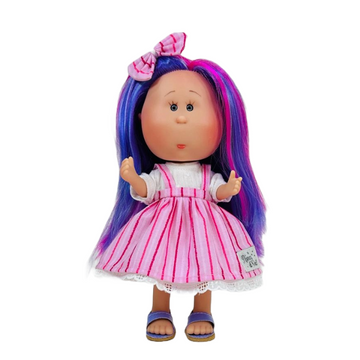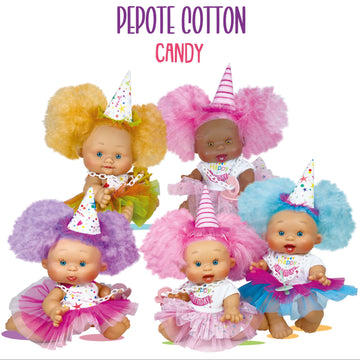See This Report about Dolls And Accessories
See This Report about Dolls And Accessories
Blog Article
What Does Dolls And Accessories Mean?
Table of ContentsAn Unbiased View of Dolls And AccessoriesSome Known Factual Statements About Dolls And Accessories The Single Strategy To Use For Dolls And AccessoriesGetting The Dolls And Accessories To WorkA Biased View of Dolls And AccessoriesTop Guidelines Of Dolls And AccessoriesDolls And Accessories for Dummies
When dolls are consisted of in team play, kids practice waiting, sharing, and paying attention to others' ideas. Whether they're acting to be a moms and dad, sibling, or pal, kids learn just how connections workhow to support others, solve differences, and treatment for somebody else. These very early role-play experiences end up being the groundwork for healthy relationships and connections later in life.Duplicating comforting routines with a doll (feeding, rocking, placing to bed) can help youngsters really feel tranquil and safe and secure. Taking treatment of a doll can make a kid really feel qualified and confident.
The Best Guide To Dolls And Accessories
When kids see dolls that show their race, heritage, and culture, it enhances a positive feeling of identification. Dolls likewise introduce children to cultures outside their very own, building respectful inquisitiveness and empathy for others.
As Dr. Karyn Purvis, a leader in youngster advancement and trauma-informed care, as soon as claimed: This powerful quote highlights how play isn't simply funit's exactly how children discover ideal. The brain cords itself with repeating. When a child is involved, cheerful, and mentally linked to an activitylike doll playthe mind strengthens those connections much faster and a lot more meaningfully.
The Ultimate Guide To Dolls And Accessories

Children need empathy, generosity, and creative imagination tooand doll play offers that. Yesdolls use something one-of-a-kind. They encourage open-ended storytelling and emotional connection in a manner couple of various other toys do. Dolls are usually a kid's very first "friend," aiding them exercise connections, develop communication abilities, and really feel comforted. Kids create their sense of self from a young age.
The 8-Second Trick For Dolls And Accessories
With dolls that matter. Samantha Ong Samantha Ong is the founder of Joeydolls, a Canadian-based plaything brand on a mission to commemorate Eastern cultures through joyful, inclusive play. Inspired by her very own experiences growing up without social representation, Samantha makes dolls that help youngsters really feel official site proud of who they are while sparking inquisitiveness and empathy in others.
Playing with dolls urges children to talk more regarding others' ideas and feelings, a research has actually found. The research suggests that playing imaginary games with dolls might assist kids create social skills, concept of mind and compassion.
9 Simple Techniques For Dolls And Accessories
They were also much more likely to address the dolls in the 2nd individual, chatting to them directly, whereas the personalities on the computer system screen they often tended to describe in the 3rd person. No distinction was observed in between kids and ladies."Interior state language can indicate that a youngster is considering various other people's ideas and emotions while having fun with dolls," stated Gerson.
And that they see language usage in this respect is good confirmation of the hypothesis."Mardell included that the searchings for ought to apply to any type of kind of role-play plaything, instead than being specific to Barbies."Children typically start to reveal indicators of inner state language around the age of four.
Not known Details About Dolls And Accessories
"It comes to be crucial for making and maintaining friendships, and just how they gain from their educators, and parents."The study also discovered that the children had enhanced brain task in the posterior exceptional temporal sulcus (pSTS) region when they talked as though their dolls had ideas and sensations. The pSTS region is believed to be associated with the development of social and emotional processing abilities.
Youth is not a static life stage; without a doubt, the interpretation, meaning and understanding of childhood years are all based on adjustment. By the nineteenth century among the most profound adjustments was the significance put on enabling youngsters to experience "the care free joys" of youth via play activities. Play was currently taken into consideration to be a vital part of a good childhood years.
In order to completely comprehend the meaning of play, one have to additionally understand the importance of the doll. However, dolls are far more than playthings designed to captivate girls. During the nineteenth century appropriate play tasks were chosen to advertise intellectual, physical or psychological advancement. Dolls were specifically popular since they were believed to foster and support womanly top qualities such as kindness, caring and empathy.
Excitement About Dolls And Accessories

It is only with archaeological investigations that scientists can intend to reveal and record the complete variety of play experiences. Narrating these experiences, and specifically the duty of dolls, is vital for offering a much more full photo of childhood throughout the nineteenth century. Alarcn, Sara E - doll clothes., "Kid's Play: The Function of Dolls in 19th Century Childhood Years" (2007 )
Report this page